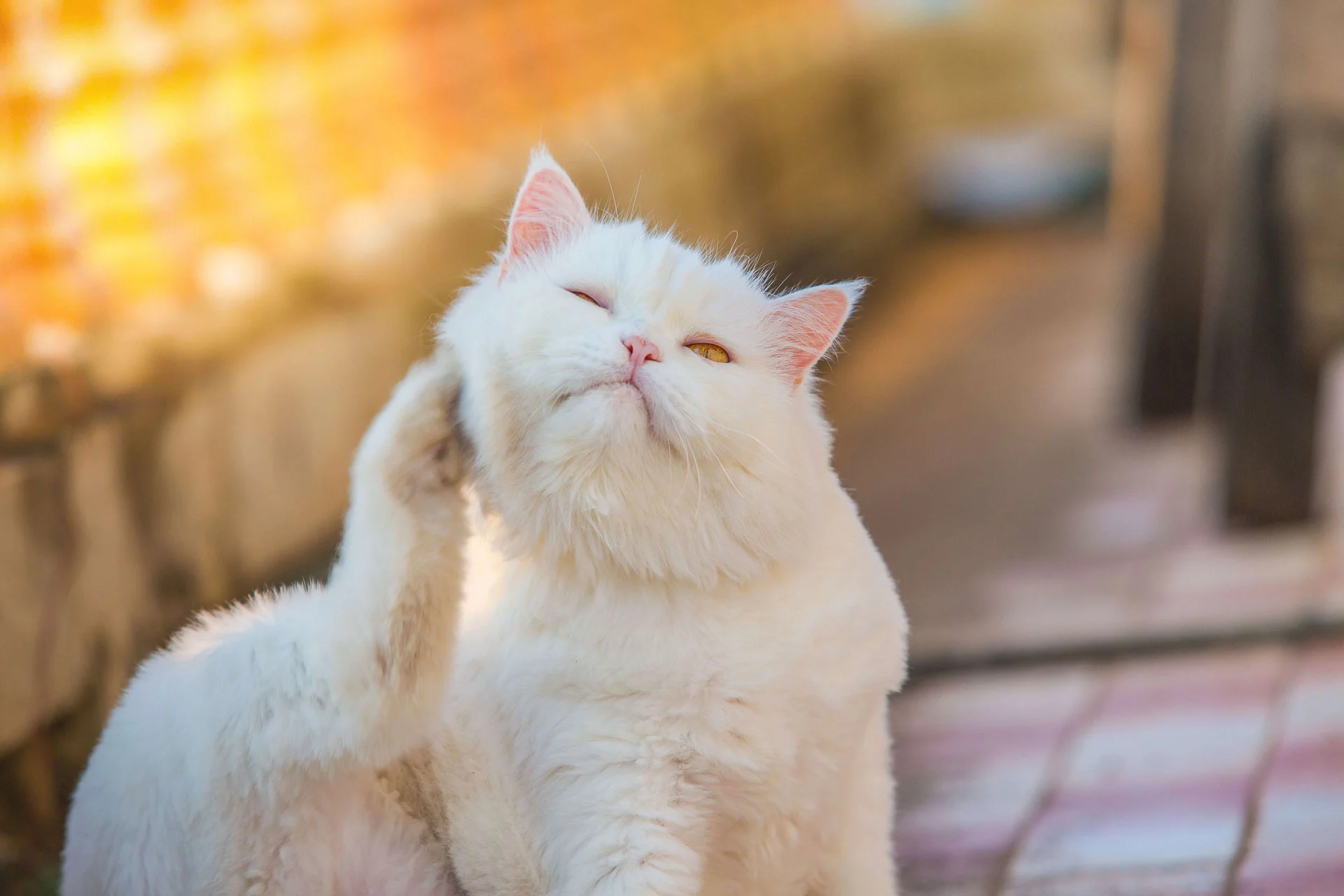
Your cat’s coat should be silky, shiny, and smooth, so if it's not, then you need these tips for treating cat shedding, dry cat skin, and more skin and coat problems in cats.
The first step toward giving your cat the luxurious coat she deserves is to try to identify the cause. Your cat's skin and coat health is a really good indicator of her overall health.
Narrowing down the cause can sometimes be the hardest part. Cat shedding, dry cat skin, and other conditions can leave your cat's coat and skin looking dull and dishevelled.
Learn more about your cat's skin problems and find easy DIY solutions that you can try at home. Let your cat have the healthy skin and beautiful coat she was meant to.
Best Cat Shedding Solutions
While you can never completely eliminate cat shedding, there are some ways you can decrease it. Dry skin, poor diet, food allergy, and infrequent grooming can all contribute to shedding.
Try these solutions:
- Moisturize Dry Skin – As if dry skin isn’t bad enough, it can also increase shedding! Add supplements that are high in omega fatty acids, like fish oil, to condition your cat's skin from the inside out.
- Change Diet – If your cat isn’t already eating a high-quality diet that includes plenty of named animal protein and wholesome fresh ingredients, you might want to think about changing your cat's food. High moisture diets are also recommended for optimal skin health.
- Groom, groom, groom – Regular grooming helps to remove loose fur, prevent tangles, and remove dirt and bacteria from the fur. It can also help discourage your cat from overgrooming, which can damage skin and fur.
Learn more about how grooming can help maintain your cat's skin and coat health in DIY Cat Grooming for Beginners.
Best Deshedding Tool for Cats
There are plenty of ways to keep your cat's skin and coat healthy to reduce excessive shedding, but you can't stop cat shedding entirely. It's a natural part of their fur cycle, so managing cat shedding will require a high-quality deshedding tool, like the Furminator Deshedding Brush for Cats.
This tool is designed to remove dead fur that is ready to fall out any minute now. A weekly deshed with this effective tool can reduce shedding up to 90% and allow you to collect the fur before it spreads all over your house and your clothes.
How to Treat Cat Dry Skin

A dry climate can wreak havoc on your cat’s skin. Other factors, including poor diet and too much bathing, can contribute to problem skin, too. Thankfully, dry skin is usually a temporary problem.
Try one of these solutions:
Curb Environmental Factors
If you believe it’s the weather that is keeping your cat’s coat dry, try a waterless cat shampoo such as Earthbath Hypo-Allergenic Grooming Foam. Simply spray and massage it into your cat’s coat for a moisturizing, no-water cleanse. Use a skin and coat care shampoo infrequently, as too much bathing can dry out the skin further.
Change Diet
If your cat is missing essential oils or vitamin E in his diet, it could very well be showing up in his skin and coat. Switching to a diet rich in omega-3 and 6 fatty acids can restore natural oils to the skin and coat. Try premium quality cat food with fish. Another alternative is to seek out a cat vitamin or supplement, such as Naturvet Vitapet Adult, which you can feed directly to your cat or mix with your cat’s food.
Reduce Bathing
If you bathe your cat frequently (once a month or more), he could be losing his natural oils too quickly to replace them. To fix this, try bathing less often. Cats are meticulous self-bathers, and most can keep themselves clean. Switch to a shampoo and/or conditioner specifically designed for skin and coat care with vitamin E, natural oils, or oatmeal. If you simply must bathe more frequently, try a very mild apple cider vinegar and water solution.
Remove Matts
If your cat’s hair clumps or mats often, chances are your cat also suffers from dry skin or excessive shedding. Check out the solutions above to help solve your problem. Mats develop because of infrequent grooming and exposure to a dirty environment.
-
- Brush your cat’s coat regularly - Remove hair before it clumps and forms a mat. Daily brushing with a slicker brush for cats is a great habit.
- Clean your cat’s litter box frequently - Mats generally appear when your cat is exposed to a dirty environment. Dirt gets caught in the fur and forms mats, which can be painful and difficult to remove.
If your cat gets a little fussy when trying to brush out mats and tangles, then give them something to occupy their mind, like a tasty treat. Or try a Messy Cat Lick Mat. Spread an Inaba Churu on it, and let your cat lick away!
For more tips on treating and preventing knots, mats, and tangles in your cat's fur, check out our top Matted Cat Fur Solutions.
Diagnosing Common Skin Issues in Cats
If your cat has all the symptoms of dry skin, but those symptoms do not improve with standard treatments, or if symptoms continue to worsen, you might be dealing with something more serious than typical dry skin. Cat food allergies, cat skin infections, anxiety, and parasites could all be factors.
It's important to speak with your veterinarian to properly diagnose health issues so that you don't end up treating incorrectly or making the problem worse.
Keep an eye out for more severe skin issues or reactions like:
-
- Signs of pests, like flea dirt or mite bites
- Hot spots or inflamed skin
- Open wounds or cuts
- Discolouration of the skin
- Bald patches
Many of these could be signs of an underlying cause for your cat's dry or itchy skin. Appropriate treatment is vital for the best outcome and to avoid further or permanent damage to your cat's skin or coat.
Some topical treatments and at-home remedies may temporarily improve symptoms, but if you don't treat the root cause, the issues will return and may be worse than before.
Cat Shedding and Dry Skin FAQs

What months do cats shed the most?
In Canada, shedding seasons happen in spring and fall, though the specific months can be different depending on your climate. As the weather begins to warm or cool significantly, your pet's coat will prepare them for whatever season is approaching.
How much shedding is normal for a cat?
All cats shed to some degree, but how much will depend on your cat's breed and your climate. Cats with a thick undercoat, like Persians, will shed a lot more than a domestic short-haired cat breed. Regular brushing will reduce how much fur ends up coating your furniture and clothing.
Do cats shed more when stressed?
Stress can be a factor in shedding. Stressful situations or big changes to your cat's environment can cause some additional shedding. Calming solutions and regular grooming habits can help reduce stress and excessive shedding.
What's the best way to moisturize my cat's skin?
Your cat's skin health is best treated from the inside out. Topical treatments might help temporarily, but your cat needs to be healthy on the inside to stay healthy on the outside. A combination of high-quality, natural, and moisture-rich foods and omega fatty acids can help to keep your cat's fur healthier for longer.
Can I rub coconut oil on my cat?
Coconut oil can be rubbed onto your cat like a lotion, but remember that your cat is an obsessive groomer and will lick a lot of it off. Use coconut oil sparingly to prevent your cat from ingesting large amounts of this high-calorie food.
.png?width=200&height=66&name=logo%20(1).png)




.jpg)
